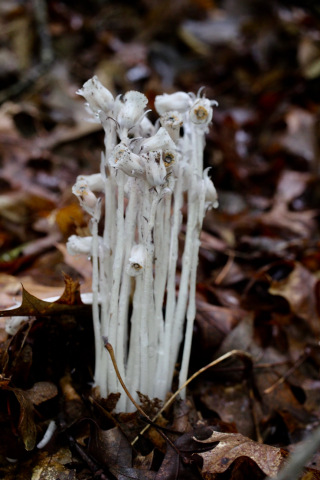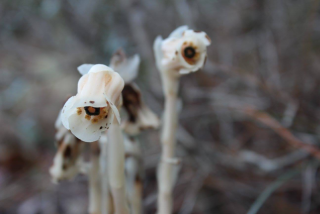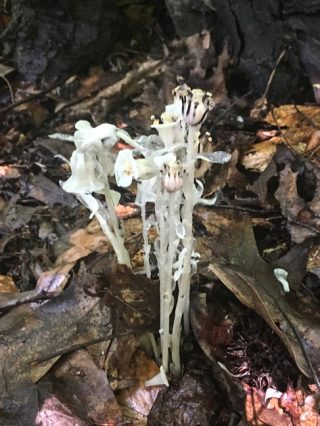Indian Pipes: The Parasitic Plants in Bloom at The New York Botanical Garden
Posted in Interesting Plant Stories on September 4, 2018 by Science Talk
Ashley Keesling is a graduate student at The Ohio State University who recently conducted a research visit to The New York Botanical Garden.

Intriguing and ethereal, Indian pipes (Monotropa uniflora) are often mistaken for fungi because of their pale, otherworldly appearance. Also known as ghost plants, they typically occur in well-established forests and are often thought of as indicators of healthy ecosystems—not the kind of plant you might think would grow in a dense urban area. However, pockets of preserved forests in New York City, such as the old-growth Thain Family Forest at The New York Botanical Garden, can allow species to flourish in unexpected places.
I came to the heart of the Bronx recently to hunt for Indian pipes in the Thain Forest as part of the research I am conducting for my master’s thesis at The Ohio State University.
These fascinating parasitic plants have been the subject of much interest over the years, including research by an early 20th Century NYBG scientist. Indian pipes are unusual in that they do not photosynthesize. Instead, they are mycoheterotrophic, meaning they obtain nutrients by parasitizing a type of fungi that associate with plant roots. These mycorrhizal fungi help the plants take up water and nutrients that might otherwise be inaccessible to the plants. In exchange, the plants provide the fungi with sugars created from the process of photosynthesis. Indian pipes take advantage of the relationship between another plant and its associated fungus and “steal” sugars from the fungus. This three-part symbiosis allows Indian pipes to ultimately get their nutrients from a photosynthetic plant through the means of a mycorrhizal fungi.

Indian pipes belong to the blueberry family (Ericaceae) and are part of a small subfamily of parasitic and hemiparasitic species. They occur across the eastern US, Pacific northwest, Mexico, Central America and eastern Asia. Although they have a wide distribution, only one species is recognized in this genus (or two if you count Monotropa hypopitys, but that is a whole different story).
That wasn’t always the case. In 1927, John K. Small, an NYBG scientist who was a leading authority on the plants of the American South, proposed the southern Indian pipe (Monotropa brittonii) as a species distinct from the closely related and much more widespread M. uniflora, most likely naming the species for Nathaniel Lord Britton or his wife Elizabeth, NYBG’s co-founders, who accompanied Small on his trip in 1919 when he first found the plant.
He described the southern Indian pipe as having larger, highly scented flowers with a slight orange coloration. Its distribution was thought to be confined mainly to Florida but potentially as far north as South Carolina. M. brittonii lost its species status in the 1970s and was synonymized with M. uniflora as the features that were originally thought to make it distinct came to be seen as normal variance that sometimes occurs in Indian pipes.

For my master’s thesis, I am investigating the differences and the relationship between Florida populations of Indian pipes and their northern relatives. I plan on using genetic, morphological and environmental data to do this. I have collected specimens widely across the United States, using valuable internet resources such as iNaturalist and the Global Biodiversity Information Facility to locate sites where Indian pipes are known to grow. These sites are databases that allow open access to occurrence information for thousands of organisms, including plants and fungi.
One of the sites I found using iNaturalist was the Thain Forest. Indian pipes are certainly flourishing there. I found them not even 10 feet down the Sweetgum Trail, poking out of the leaf litter. Their blooming season is drawing to a close, however, so if you want to see them for yourself, now is the time to make the trip.

